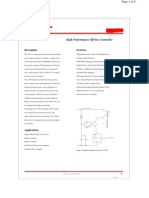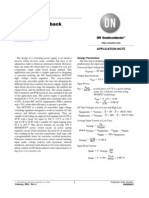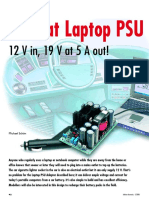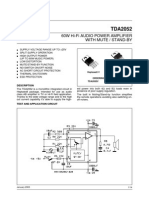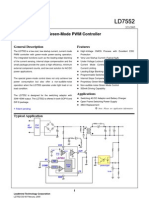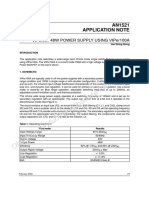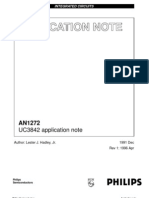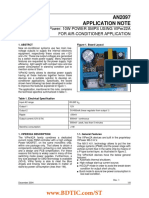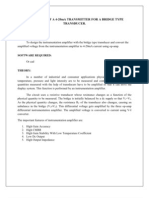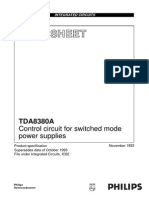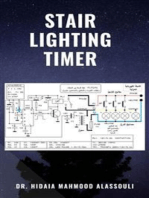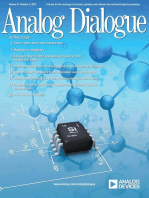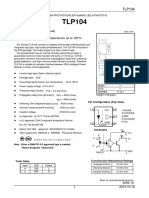Obsolete Product(s) - Obsolete Product(s) Obsolete Product(s) - Obsolete Product(s)
Obsolete Product(s) - Obsolete Product(s) Obsolete Product(s) - Obsolete Product(s)
Uploaded by
teomondoCopyright:
Available Formats
Obsolete Product(s) - Obsolete Product(s) Obsolete Product(s) - Obsolete Product(s)
Obsolete Product(s) - Obsolete Product(s) Obsolete Product(s) - Obsolete Product(s)
Uploaded by
teomondoOriginal Title
Copyright
Available Formats
Share this document
Did you find this document useful?
Is this content inappropriate?
Copyright:
Available Formats
Obsolete Product(s) - Obsolete Product(s) Obsolete Product(s) - Obsolete Product(s)
Obsolete Product(s) - Obsolete Product(s) Obsolete Product(s) - Obsolete Product(s)
Uploaded by
teomondoCopyright:
Available Formats
AN1539
- APPLICATION NOTE
VIPower: LOW COST UNIVERSAL INPUT SMPS
FOR DIGITAL SET-TOP BOX BASED ON VIPer50
F. Gennaro
ABSTRACT
In this paper the design of a low cost power supply for digital Set Top Box (STB) is introduced. The
converter uses VIPower VIPer50 in Flyback configuration with secondary isolated output regulation and
provides 6 isolated outputs. The power supply is suitable for universal input range as required by such a
consumer application.
)
s
t(
INTRODUCTION
Set-top boxes (STB) are commonly used for connecting to satellite and cable TV providers and to play
c
u
d
TV video games. These consumer devices, typically placed on top of TV sets, interact with the signal
o
r
P
processing circuits of television and VCR. It represents an optimal integration between information and
entertainment, also providing in-home Internet access, interactive information, streaming video and
e
t
le
electronic programming through a traditional television set and a cable or a telephone line.
Thanks to such features, worldwide digital set-top box sales, including cable, satellite and terrestrial
o
s
b
O
-
platforms, are projected to grow from 28 million units in 2000, to 45 million units in 2004.
Several circuits make up a STB, such as digital circuitry, SCART port, LNB regulator and tuner supply.
Single on-board power supply is required to feed all these circuits, providing low cost and worldwide
)
s
(
ct
mains usage. The major concern is cost since STB is going to become a widespread consumer product.
In this paper the design of a low cost power supply for digital Set Top Box is introduced. The converter
uses VIPower VIPer50 in Flyback configuration with output regulation by means of optocoupler and
u
d
o
TL431. It has been designed for wide range input voltage, i.e. 85-265Vac, to supply 20W output power
r
P
e
on six outputs.
The VIPer is a family of monolithic smart power that makes easier size and cost savings for multi output
t
e
l
o
power supplies, providing integrated start-up and protection circuits such as current limiting, thermal
shutdown and over/under voltage detection.
s
b
O
1. APPLICATION DESCRIPTION AND DESIGN
The proposed power supply has been designed referenced to the specifications listed in Table 1. The
switching frequency has been selected considering both transformer size and EMI behavior; in fact the
harmonics to be evaluated will start from the third one since the frequency range is 150kHz-30MHz for
conducted emissions according to EN55022 standard.
The target efficiency is 70% higher with a maximum duty cycle of 45% at minimum input voltage in
discontinuous conduction mode.
March 2002
1/15
AN1539 - APPLICATION NOTE
The regulation is performed on the lowest voltage output, i.e. 2.5V, and cross regulation is achieved by
means of a simple circuit and optimized transformer coupling. All the outputs are directly connected to
the load, except for the 3.3V. In fact, this output is provided using a standard linear voltage regulator on
the 5V output in order to assure high accuracy.
The input EMI filter consists in a Pi-filter for both differential and common mode emissions. In order to
improve the efficiency, a Transil clamper is used instead of a standard RCD clamper that would dissipate
power at any operating condition.
The VIPer makes power supply design easier considering start-up, sensing and no-load issues,
improving the overall efficiency and simplifying the circuit. The short circuit protection is provided with
hiccup mode for every output with the exception of 2.5V and 5V outputs that need a simple auxiliary
circuit. A leading edge blanking circuit (Q1, C16, R14) that masks voltage spikes at turn off is also used
to improve short circuit behavior. A zener diode can be connected on COMP pin in order to clamp the
)
s
t(
voltage on such a pin and thus limiting the maximum output power. However an input 5*20 fuse is used
c
u
d
to protect the system against catastrophic failures. The input section also has an NTC to limit the inrush
current of the bulk capacitor during the start-up of the power supply.
o
r
P
The switching frequency is set by R3 and C4 according to the diagram given in the datasheet. C3 is the
VIPer supply capacitor connected on VDD pin and an RC network (R4, C6) is also connected on VDD
e
t
le
giving extra protection against lighting and surge spikes.
Moreover, the VIPer has a built-in burst mode circuit that allows cycle skipping under low load condition,
improving stand-by performance.
Table 1: SMPS specifications
Input voltage
Output power
Outputs
Out1
Out2
Out3
Out4
Out5
Out6
Switching frequency
(s)
t
c
u
d
o
r
P
e
t
e
l
o
s
b
O
o
s
b
O
-
85-265 Vac
16W
6
2.5V at 800mA, P1=2W, 2%
3.3V at 600mA, P2=1.98W, 2%
5V at 350mA, P3=1.75W, 2%
12V at 100mA, P4=1.2W, 5%
22V at 400mA, P5=8.8W, 5%
30V at 10mA, P6=0.06W, 10%
70 kHz
1.1 TRANSFORMER CONSIDERATIONS
In multi-output isolated converters the transformer is of primary concern since output voltage regulation
and cross regulation are based on winding coupling.
In the considered application the Flyback transformer has 7 windings, since one winding is dedicated to
supply the VIPer, as listed in Table 2. Winding arrangement is shown in Figure 1, while transformer pin-
2/15
AN1539 - APPLICATION NOTE
out is shown in Figure 2. The reflected voltage has been set to 70V, in order to have room for leakage
inductance spike. The transformer is a slot type manufactured by OREGA. In this demo board an ETD29
core has been used, allowing further increase of the output power, but a smaller core, e.g. ETD20, is
suitable for the considered power level.
Table 2: Transformer features
Core
Al
Primary inductance
Leakage inductance
Windings specs
Output 2.5V
Output 5V
Output 12V
Output 22V
Output 30V
Aux
ETD29
180 nH
832uH 10%
16uH (typical)
Thomson B2
68 turns
2 turns
4 turns
8 turns
7 turns
20 turns
9 turns
Figure 1: Transformer layout
e
t
le
DC INPUT
(t s)
o
s
b
O
-
od
uc
r
P
e
t
e
l
o
bs
DRAIN
VCC
GROUND
17
+30V
16
+22V
15
+12V
12
GROUND
11
+5V
14
+2.5V
13
GROUND
c
u
d
)
s
t(
o
r
P
PRIMARY SIDE
SECONDARY SIDE
3/15
AN1539 - APPLICATION NOTE
Figure 2: Transformer pin out
0.1
(Cu SIDE)
12
10
14
20
16
0.1
11
13
15
1.3
4
17
0.1
32
c
u
d
)
s
t(
o
r
P
The design of the transformer windings has been done according to (1). Once the primary inductance
value and turns ratio Np/NOL , between primary and lowest voltage output, is selected, Vt parameter, volt-
e
t
le
per-turn value, can be calculated. Then, all the other turn values are given by (2).
o
s
b
O
-
V + VD
Vt = OL
N OL
V
)
s
t(
NOk =
WHERE
o
r
P
e
c
u
d
+ VD
Vt
(1)
Ok
(2)
VD is the diode forward voltage drop, i.e. 0.7V for PN diodes and 0.4V for Schottky diodes, k is
related to the kth output. Either kind of diodes, fast recovery PN or Schottky barrier, are used in order to
adjust the related output voltage.
t
e
l
o
1.2 OUTPUT RECTIFIER DIODES SELECTION
s
b
O
The selection of the output rectifier diodes has been done considering reverse voltage and forward
current rating, as defined in (3) and (4).
N
Vk max = VOk + VDC max Ok
Np
I k max =
2 IOk max
1 Dmax
(3)
(4)
4/15
AN1539 - APPLICATION NOTE
where Vo is the considered output voltage, VDCmax is maximum input DC voltage, No is the number of
turns and Np is the primary turns.
1.3 OUTPUT FILTER CAPACITORS
Output capacitors values depend on the output current, voltage ripple and switching frequency according
to (5).
COk =
fsw
IOk max
VOk _ ripple
(5)
1.4 VOLTAGE FEEDBACK
The voltage feedback is provided using a TL431 on the 2.5V output and an optocoupler. The voltage at
)
s
t(
the collector of the optocoupler sets the peak drain current of the VIPer device. Feedback compensation
circuit is connected across TL431 cathode and reference pin.
c
u
d
For a given current sank from COMP pin of the VIPer in order to perform proper voltage regulation, the
LED current is calculated considering the optocoupler transfer ratio Ctrr of 200%, then the limiting resistor
of the LED current Rlim can be calculated according to (6).
[5V (V + VLED ]
R lim =
I LED
o
s
b
O
-
e
t
le
o
r
P
(6)
In order to improve the regulation of 5V output, the output voltage sensing is split using two resistors, as
shown in Figure 3. In fact, this output is usually connected to voltage sensitive circuits such as
)
s
(
ct
microprocessors and other low voltage logic devices.
u
d
o
r
P
e
t
e
l
o
s
b
O
5/15
AN1539 - APPLICATION NOTE
Figure 3: Circuit schematic
c
u
d
e
t
le
)
s
(
ct
)
s
t(
o
r
P
o
s
b
O
-
u
d
o
r
P
e
t
e
l
o
s
b
O
6/15
AN1539 - APPLICATION NOTE
Table 3: Component list
Symbol
Value
F1
T2AL250V
R3
2.2 k
R4
39 k
R5
1 k
R6
8.2 k
R7
220
R8
5.6 k
R9
5.6 k
R10
1 k
R11
1.8 k
R12
150
R14
1 k
R15
2.7 k
R16
270
R17
1 k
R18
1 k
C1
68uF 400V
r
P
e
C4
t
e
l
o
C6
s
b
O
C8
Fuse 5x20
c
u
d
e
t
le
)
s
t(
o
r
P
o
s
b
O
-
u
d
o
C3
C7
)
s
(
ct
Note
47uF 25V
12 nF 25V
22 nF 25V
330 nF 25V
2200 uF 25V
C9
220 uF 50V
C10
100 uF 25V
C11
2200 uF 25V
C12
100 nF 250V
X2 capacitor
7/15
AN1539 - APPLICATION NOTE
C13
100 nF 250V
C15
100 uF 10V
C16
1 nF 25V
C17
22 uF 50V
C18
100nF
C25
47 uF 10V
C26
2.2nF
D1
DF06M
D2
STTH106
D3
1N4148
STMicroelectronics
D4
BYT01-400
STMicroelectronics
D5
BYW100-200
STMicroelectronics
D6
1N5820
STMicroelectronics
D7
BYW98-100
STMicroelectronics
D9
P6K180A
D10
1N4752A - 33V
D11
BYW100-200
D12
1N4148
D13
1N4148
)
s
(
ct
e
t
le
c
u
d
)
s
t(
o
r
P
so
STMicroelectronics
b
O
-
BC556
r
P
e
Q2
Q3
t
e
l
o
L1
bs
1A 600V
u
d
o
Q1
T1
X2 capacitor
BC548A
BC548A
330 nH
OREGA
T2
15 mH
S+M B82732
IC1
VIPer50(022Y)
STMicroelectronics
IC2
SFH617A
IC3
STLD33V
STMicroelectronics
IC4
TL431
STMicroelectronics
8/15
AN1539 - APPLICATION NOTE
Figure 4: PCB layout (not in scale)
c
u
d
)
s
t(
o
r
P
The board has been developed on a 135X75 Cu single side 70mm FR-4 frame.
e
t
le
2. LAYOUT RECOMMENDATION
Since EMI issues are strongly related to layout, a basic rule has to be taken into account in high current
o
s
b
O
-
path routing, i.e. the current loop area has to be minimized.
If a heatsink is used it has to be connected to ground too, in order to reduce common mode emissions
)
s
(
ct
since it is close to the floating drain tab.
One more consideration has to be done regarding the control ground connection: in fact in order to avoid
any noise interference on VIPer logic pin the control ground has to be separated from power ground. This
u
d
o
results in a dedicated track for ground connection of C3, C4, C6, C9 and IC2 collector.
r
P
e
3. EXPERIMENTAL RESULTS
t
e
l
o
3.1 PERFORMANCE AND TYPICAL WAVEFORMS
In this section the performances of the power supply in terms of voltage regulation, power consumption
s
b
O
as well as typical waveforms are given.
In Table 4 and 5 the main experimental results are listed. The converter features an excellent voltage
regulation as the input voltage changes, with low power consumption at no load and efficiency 70%
higher at full load. In Figure 5 and 6 the drain voltage VDS at 110Vac and 220Vac at no-load and full load
is shown, respectively. In Figure 7 VDS during the first cycles at start up is shown: the voltage never goes
higher than 600V, below the breakdown voltage. Start up transient is shown in Figure 8 at 110Vac and
220Vac respectively. Thanks to the internal current generator, that provides constant 2mA current, the
9/15
AN1539 - APPLICATION NOTE
start up time is independent of the input voltage and depends only on the VDD capacitor.
The voltage ripple at full load in the main outputs, i.e. 2.5V, 5V, 12V and 22V, is shown in Figure 9.
Table 4: Voltage regulation and power dissipation at no-load, Tamb=30C
Vinac
(Vrms)
Pin
(W)
Vout1
(V)
Vout2
(V)
Vout3
(V)
Vout4
(V)
Vout5
(V)
Vout6
(V)
85
115
230
265
1
1.1
1.4
1.45
2.53
2.53
2.53
2.53
3.28
3.28
3.28
3.28
5.41
5.41
5.40
5.40
12.91
12.92
12.90
12.89
24.6
24.7
24.6
24.6
32.5
32.5
32.5
32.5
Table 5: Voltage regulation and efficiency at full-load, Tamb=30C.
Vinac
(Vrms)
Vout1
(V)
Vout2
(V)
Vout3
(V)
Vout4
(V)
85
71%
2.49
3.24
5.18
12.05
115
230
265
73%
74%
73%
2.49
2.50
2.49
3.24
3.24
3.24
5.19
5.18
5.19
12.05
12.05
12.05
Figure 5: VDS at no load at 110Vac and 220Vac
)
s
(
ct
o
s
b
O
-
e
t
le
c
u
d
Vout5
(V)
o
r
P
)
s
t(
Vout6
(V)
22.2
32.9
22.2
22.1
22.1
32.8
32.8
32.9
u
d
o
r
P
e
t
e
l
o
s
b
O
10/15
AN1539 - APPLICATION NOTE
Figure 6: VDS at full load at 110Vac and 220Vac
c
u
d
e
t
le
)
s
t(
o
r
P
o
s
b
O
-
Figure 7: VDS during start-up at 110Vac and 220Vac
)
s
(
ct
u
d
o
r
P
e
t
e
l
o
s
b
O
11/15
AN1539 - APPLICATION NOTE
Figure 8: Start-up time at 110Vac and 220Vac
c
u
d
e
t
le
Figure 9: Output voltage ripple at Vin=220Vac: 1) 2.5V, 2) 5V, 3) 12V, 4) 22V
)
s
(
ct
)
s
t(
o
r
P
o
s
b
O
-
u
d
o
r
P
e
t
e
l
o
s
b
O
12/15
AN1539 - APPLICATION NOTE
3.2 SHORT CIRCUIT BEHAVIOUR
Short circuit protection is provided on any output by means of winding coupling for higher voltage outputs
and by means of an auxiliary circuit for 2.5V and 5V outputs (Q1 and Q3 and Figure 3). In the first case
the power supply works in hiccup mode while in the second case the output power is limited driving the
COMP pin through the optocoupler. In Figure 10 drain and VDD voltages are shown as the 22V output is
short-circuited at Vin=110Vac and Vin=220Vac. In both cases the power dissipation is limited since the
power supply works only for some ms. In Figure 11 start-up voltages are shown under short circuit
condition on 22V output at Vin=110Vac and Vin=220Vac.
Figure 10: Short circuit at Poutmax on 22V output (Vin=110Vac and Vin=220Vac)
c
u
d
e
t
le
)
s
(
ct
)
s
t(
o
r
P
o
s
b
O
-
u
d
o
Figure 11: Short circuit at Poutmax on 22V output (Vin=110Vac and Vin=265Vac)
r
P
e
t
e
l
o
s
b
O
13/15
AN1539 - APPLICATION NOTE
3.3 EMI MEASUREMENTS
Conducted EMI measurements have been performed according to EN55022 Class B standard, using a
50W LISN and a spectrum analyzer. In Figure 12 and Figure 13 measurement results are shown under
full load condition at nominal 115Vac and 230Vac input voltage, respectively. Although peak detector has
been used, the measured emission levels are below the AV (average) limit, passing the pre-compliance
test.
Figure 12: Conducted emissions at 110Vac (limits EN55022B)
REF 75 dBV
c
u
d
e
t
le
150 kHz
)
s
(
ct
o
s
b
O
-
)
s
t(
o
r
P
30 MHz
Figure 13: Conducted emissions at 220Vac (limits EN55022B)
u
d
o
r
P
e
REF 75 dBV
t
e
l
o
s
b
O
150kHz
30 MHz
14/15
AN1539 - APPLICATION NOTE
3.4 THERMAL MEASUREMENTS
Temperature measurements have been performed in order to provide reliable operation conditions for all
the circuit components. In Table 6 the measured values with Tamb=23C. Only one heatsink has been
used in the board, mounted on the VIPer50.
Table 6: Temperature characterization
Device
T at 110Vac
T at 220Vac
Transformer
66
97
66
75
55
44
64
103
67
78
58
43
Bridge
54
46
VIPer50
Transil
D6 (22V)
D8 (5V)
D9 (2.5V)
c
u
d
)
s
t(
4. CONCLUSIONS
In this paper a low cost SMPS for Set-Top-Box has been introduced and analyzed. Thanks to VIPer
o
r
P
features the design and development of the power supply are really straightforward, yielding to a cost
e
t
le
effective solution. The built-in functions and protections of the VIPer reduce the external component
count, simplifying the circuit. Moreover, EMI behavior and thermal performance allow to use standard
o
s
b
O
-
components and materials for the PCB, keeping low the cost of the whole system.
The voltage regulation performance confirms the VIPer as the device of choice for low cost high
performance power supplies as required by the consumer market.
)
s
(
ct
For further information please contact STMicroelectronics VIPower web site: www.st.com/vipower.
u
d
o
r
P
e
Information furnished is believed to be accurate and reliable. However, STMicroelectronics assumes no responsibility for the consequences
of use of such information nor for any infringement of patents or other rights of third parties which may results from its use. No license is
granted by implication or otherwise under any patent or patent rights of STMicroelectronics. Specifications mentioned in this publication are
subject to change without notice. This publication supersedes and replaces all information previously supplied. STMicroelectronics products
are not authorized for use as critical components in life support devices or systems without express written approval of STMicroelectronics.
The ST logo is a trademark of STMicroelectronics
s
b
O
t
e
l
o
2002 STMicroelectronics - Printed in ITALY- All Rights Reserved.
STMicroelectronics GROUP OF COMPANIES
Australia - Brazil - Canada - China - Finland - France - Germany - Hong Kong - India - Israel - Italy - Japan - Malaysia Malta - Morocco - Singapore - Spain - Sweden - Switzerland - United Kingdom - U.S.A.
http://www.st.com
15/15
You might also like
- CCIE Enterprise Infrastructure Real Lab 1 Demo 3100% (1)CCIE Enterprise Infrastructure Real Lab 1 Demo 395 pages
- AND8099/D 5.0 V, 2.0 A Flyback Converter: Application NoteNo ratings yetAND8099/D 5.0 V, 2.0 A Flyback Converter: Application Note8 pages
- 95-Wat Laptop PSU 12V in - 19V 5A Out PDFNo ratings yet95-Wat Laptop PSU 12V in - 19V 5A Out PDF7 pages
- LG L172wal LCD Monitor Training Manual (ET)No ratings yetLG L172wal LCD Monitor Training Manual (ET)45 pages
- Ncl30160 1.0A Constant-Current Buck Regulator For Driving High Power LedsNo ratings yetNcl30160 1.0A Constant-Current Buck Regulator For Driving High Power Leds10 pages
- DC-DC Boost Converter For Custom Application by LeenaNo ratings yetDC-DC Boost Converter For Custom Application by Leena4 pages
- VIPower: 10W POWER SMPS USING VIPer22A FOR AIR-CONDITIONER APPLICATIONNo ratings yetVIPower: 10W POWER SMPS USING VIPer22A FOR AIR-CONDITIONER APPLICATION8 pages
- Application Note An-985: Six-Output 600V Mgds Simplify 3-Phase Motor DrivesNo ratings yetApplication Note An-985: Six-Output 600V Mgds Simplify 3-Phase Motor Drives12 pages
- SG3524 SMPS Control Circuit: Description Pin ConfigurationNo ratings yetSG3524 SMPS Control Circuit: Description Pin Configuration5 pages
- Chapter-1 Objective: 1.1 Objective of The ProjectNo ratings yetChapter-1 Objective: 1.1 Objective of The Project23 pages
- Designing Amplifiers With Tripath'S High-Power Class-T DriversNo ratings yetDesigning Amplifiers With Tripath'S High-Power Class-T Drivers9 pages
- Block Diagram For Simple Traffic Light System88% (16)Block Diagram For Simple Traffic Light System17 pages
- A Complete Narrow-Band Power Line Communication Node For AMRNo ratings yetA Complete Narrow-Band Power Line Communication Node For AMR6 pages
- Forward Design 300W STmicroelectronics App NoteNo ratings yetForward Design 300W STmicroelectronics App Note10 pages
- M62301SP, FP: Description Pin Configuration (Top View)No ratings yetM62301SP, FP: Description Pin Configuration (Top View)9 pages
- Tops Witc H-Iifamily: Three-Terminal Off-Line PWM Switch0% (1)Tops Witc H-Iifamily: Three-Terminal Off-Line PWM Switch32 pages
- Reference Guide To Useful Electronic Circuits And Circuit Design Techniques - Part 2From EverandReference Guide To Useful Electronic Circuits And Circuit Design Techniques - Part 2No ratings yet
- Reference Guide To Useful Electronic Circuits And Circuit Design Techniques - Part 1From EverandReference Guide To Useful Electronic Circuits And Circuit Design Techniques - Part 12.5/5 (3)
- Design of Electrical Circuits using Engineering Software ToolsFrom EverandDesign of Electrical Circuits using Engineering Software ToolsNo ratings yet
- TLP2398 TLP2398 TLP2398 TLP2398: 1. 1. 1. 1. Applications Applications Applications ApplicationsNo ratings yetTLP2398 TLP2398 TLP2398 TLP2398: 1. 1. 1. 1. Applications Applications Applications Applications18 pages
- Shlepnev PCB DesignMagazine Oct2014 FinalNo ratings yetShlepnev PCB DesignMagazine Oct2014 Final9 pages
- Radiated Emissions of Multilayered Coreless Planar TransformerNo ratings yetRadiated Emissions of Multilayered Coreless Planar Transformer6 pages
- High-Speed (MHZ) Series Resonant Converter (SRC)No ratings yetHigh-Speed (MHZ) Series Resonant Converter (SRC)12 pages
- G19 JustPics ProductRecommendationSystem ReportNo ratings yetG19 JustPics ProductRecommendationSystem Report36 pages
- MDCM, Inc. (A) : IT Synchronization StrategyNo ratings yetMDCM, Inc. (A) : IT Synchronization Strategy5 pages
- Razberi Monitor™: Remote Monitoring and Management For Physical Security SystemsNo ratings yetRazberi Monitor™: Remote Monitoring and Management For Physical Security Systems2 pages
- Consumer Information Sheet (Wait List Id: 4424151)No ratings yetConsumer Information Sheet (Wait List Id: 4424151)2 pages
- Research Methodology Fundamentals of Marketing ResearchNo ratings yetResearch Methodology Fundamentals of Marketing Research17 pages
- Identify The Key Features of Security Tools100% (1)Identify The Key Features of Security Tools3 pages
- SN54LS169B, SN54S169 SN74LS169B, SN74S169 Synchronous 4-Bit Up/Down Binary CountersNo ratings yetSN54LS169B, SN54S169 SN74LS169B, SN74S169 Synchronous 4-Bit Up/Down Binary Counters12 pages
- Politica de Regulacion de Poppo Live PDF 241222 113204No ratings yetPolitica de Regulacion de Poppo Live PDF 241222 11320414 pages
- Fortimo Led Module Product Leaflet Philips DLM Gen5No ratings yetFortimo Led Module Product Leaflet Philips DLM Gen56 pages
- AND8099/D 5.0 V, 2.0 A Flyback Converter: Application NoteAND8099/D 5.0 V, 2.0 A Flyback Converter: Application Note
- Ncl30160 1.0A Constant-Current Buck Regulator For Driving High Power LedsNcl30160 1.0A Constant-Current Buck Regulator For Driving High Power Leds
- DC-DC Boost Converter For Custom Application by LeenaDC-DC Boost Converter For Custom Application by Leena
- VIPower: 10W POWER SMPS USING VIPer22A FOR AIR-CONDITIONER APPLICATIONVIPower: 10W POWER SMPS USING VIPer22A FOR AIR-CONDITIONER APPLICATION
- Application Note An-985: Six-Output 600V Mgds Simplify 3-Phase Motor DrivesApplication Note An-985: Six-Output 600V Mgds Simplify 3-Phase Motor Drives
- SG3524 SMPS Control Circuit: Description Pin ConfigurationSG3524 SMPS Control Circuit: Description Pin Configuration
- Designing Amplifiers With Tripath'S High-Power Class-T DriversDesigning Amplifiers With Tripath'S High-Power Class-T Drivers
- A Complete Narrow-Band Power Line Communication Node For AMRA Complete Narrow-Band Power Line Communication Node For AMR
- M62301SP, FP: Description Pin Configuration (Top View)M62301SP, FP: Description Pin Configuration (Top View)
- Tops Witc H-Iifamily: Three-Terminal Off-Line PWM SwitchTops Witc H-Iifamily: Three-Terminal Off-Line PWM Switch
- Reference Guide To Useful Electronic Circuits And Circuit Design Techniques - Part 2From EverandReference Guide To Useful Electronic Circuits And Circuit Design Techniques - Part 2
- Reference Guide To Useful Electronic Circuits And Circuit Design Techniques - Part 1From EverandReference Guide To Useful Electronic Circuits And Circuit Design Techniques - Part 1
- Analog Dialogue, Volume 45, Number 2: Analog Dialogue, #2From EverandAnalog Dialogue, Volume 45, Number 2: Analog Dialogue, #2
- Design of Electrical Circuits using Engineering Software ToolsFrom EverandDesign of Electrical Circuits using Engineering Software Tools
- Analog Dialogue, Volume 48, Number 1: Analog Dialogue, #13From EverandAnalog Dialogue, Volume 48, Number 1: Analog Dialogue, #13
- Analog Dialogue, Volume 45, Number 3: Analog Dialogue, #3From EverandAnalog Dialogue, Volume 45, Number 3: Analog Dialogue, #3
- Analog Dialogue, Volume 46, Number 3: Analog Dialogue, #7From EverandAnalog Dialogue, Volume 46, Number 3: Analog Dialogue, #7
- Analog Dialogue, Volume 45, Number 4: Analog Dialogue, #4From EverandAnalog Dialogue, Volume 45, Number 4: Analog Dialogue, #4
- TLP2398 TLP2398 TLP2398 TLP2398: 1. 1. 1. 1. Applications Applications Applications ApplicationsTLP2398 TLP2398 TLP2398 TLP2398: 1. 1. 1. 1. Applications Applications Applications Applications
- Radiated Emissions of Multilayered Coreless Planar TransformerRadiated Emissions of Multilayered Coreless Planar Transformer
- Razberi Monitor™: Remote Monitoring and Management For Physical Security SystemsRazberi Monitor™: Remote Monitoring and Management For Physical Security Systems
- Consumer Information Sheet (Wait List Id: 4424151)Consumer Information Sheet (Wait List Id: 4424151)
- Research Methodology Fundamentals of Marketing ResearchResearch Methodology Fundamentals of Marketing Research
- SN54LS169B, SN54S169 SN74LS169B, SN74S169 Synchronous 4-Bit Up/Down Binary CountersSN54LS169B, SN54S169 SN74LS169B, SN74S169 Synchronous 4-Bit Up/Down Binary Counters
- Politica de Regulacion de Poppo Live PDF 241222 113204Politica de Regulacion de Poppo Live PDF 241222 113204
- Fortimo Led Module Product Leaflet Philips DLM Gen5Fortimo Led Module Product Leaflet Philips DLM Gen5





